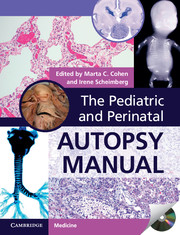Book contents
- Frontmatter
- Contents
- List of contributors
- Foreword
- Preface
- Acknowledgments
- 1 Perinatal autopsy, techniques, and classifications
- 2 Placental examination
- 3 The fetus less than 15 weeks gestation
- 4 Stillbirth and intrauterine growth restriction
- 5 Hydrops fetalis
- 6 Pathology of twinning and higher multiple pregnancy
- 7 Is this a syndrome? Patterns in genetic conditions
- 8 The metabolic disease autopsy
- 9 The abnormal heart
- 10 Central nervous system
- 11 Significant congenital abnormalities of the respiratory, digestive, and renal systems
- 12 Skeletal dysplasias
- 13 Congenital tumors
- 14 Complications of prematurity
- 15 Intrapartum and neonatal death
- 16 Sudden unexpected death in infancy
- 17 Infections and malnutrition
- 18 Role of MRI and radiology in post mortems
- 19 The forensic post mortem
- 20 Appendix tables
- Index
- References
9 - The abnormal heart
Published online by Cambridge University Press: 05 September 2014
- Frontmatter
- Contents
- List of contributors
- Foreword
- Preface
- Acknowledgments
- 1 Perinatal autopsy, techniques, and classifications
- 2 Placental examination
- 3 The fetus less than 15 weeks gestation
- 4 Stillbirth and intrauterine growth restriction
- 5 Hydrops fetalis
- 6 Pathology of twinning and higher multiple pregnancy
- 7 Is this a syndrome? Patterns in genetic conditions
- 8 The metabolic disease autopsy
- 9 The abnormal heart
- 10 Central nervous system
- 11 Significant congenital abnormalities of the respiratory, digestive, and renal systems
- 12 Skeletal dysplasias
- 13 Congenital tumors
- 14 Complications of prematurity
- 15 Intrapartum and neonatal death
- 16 Sudden unexpected death in infancy
- 17 Infections and malnutrition
- 18 Role of MRI and radiology in post mortems
- 19 The forensic post mortem
- 20 Appendix tables
- Index
- References
Summary
Introduction
The pathology of the heart in the pediatric age group can be divided into that of congenital lesions and postnatally acquired heart disease. Acquired disease in the setting of congenital heart disease is achieving increasing significance, with more surgery being performed on even very complex cases with long-term survival. Pathologists need not only be familiar with congenital heart lesions, but the complex surgical techniques which have evolved since the 1940s in dealing with these cardiac lesions.
While adult cardiac autopsy concentrates on coronary artery disease, in children congenital cardiac lesions predominate [1,2]. The incidence of congenital heart disease has been estimated at approximately 8 per 1000 live births [3]. Incidence in stillbirths is higher [4]. Many pathologists are totally ignorant and apprehensive concerning a congenitally malformed heart and the complex procedures evolved over the years in dealing with these lesions.
Although congenital heart disease is the most prevalent form of heart pathology in the fetus and child, other types of heart disease occur, with their own challenges for the autopsy prosector. These include cardiomyopathies with a very wide range of rare metabolic and genetic causes, myocarditis that can masquerade as sudden infant death syndrome (SIDS) or cause sudden death, and certain heart tumors that primarily affect children. Many of these conditions have genetic associations with potential consequences to current and future siblings, necessitating an accurate and clinically relevant diagnosis. Autopsy of the fetal or pediatric heart is further challenged by the macerated stillbirth, very small pre-term fetus, and disrupted terminated conceptus that often present to the pathology laboratory. Congenital heart disease in a fetus or infant may have been identified by ante mortem clinical investigations or be a complete surprise at autopsy.
- Type
- Chapter
- Information
- The Pediatric and Perinatal Autopsy Manual , pp. 139 - 172Publisher: Cambridge University PressPrint publication year: 2000



